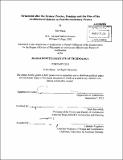Ornament after the orders : Percier, Fontaine and the rise of the architectural interior in post-revolutionary France
Author(s)
Moon, Iris (Iris Jee)
DownloadFull printable version (65.66Mb)
Alternative title
Percier, Fontaine and the rise of the architectural interior in post-revolutionary France
Other Contributors
Massachusetts Institute of Technology. Department of Architecture.
Advisor
Mark Jarzombek.
Terms of use
Metadata
Show full item recordAbstract
This dissertation explores the collaborative work in interior decoration undertaken by the French architects Charles Percier (1764-1838) and Pierre-François-Léonard Fontaine (1762- 1853), in order to argue that their shared aesthetic positioned the interior at the crux of a modem architectural discourse no longer dependent upon a Vitruvian theory of the orders. Percier and Fontaine's influential decoration book, the Recueil de décorations intérieures (1801-1812) serves as my point of departure for investigating their idea of interior decoration and its engagement with the complex cultural milieu of France, circa 1800, from the end of the ancien régime to the rise of a militarized empire under Napoleon Bonaparte. Approaching Percier and Fontaine's interior decoration partnership from different thematic angles, this interdisciplinary study demonstrates their vital role in shaping the unexpected contours of modem architectural thought. Against the widespread revolutionary destruction of monuments, ornament, rather than the orders, ensured architecture's survival. Percier and Fontaine's vision of the interior signaled a movement away from an architecture of monumentality towards one of mobility, a shift precipitated by the violence of political events, the disciplinary pressure of engineering and the emergence of new conceptions of history. Scholars have argued that the utilitarian techniques of engineering constituted the primary impetus behind the formation of a post-Vitruvian building culture in France. By contrast, Percier and Fontaine reaffirmed architecture's alliance with sculpture, painting and engraving, harnessing these artistic forms to new ends in their design practice. Through the Recueil, Percier and Fontaine claimed the interior-untouched by the spatial symbolics of the revolution-as architectural theory's proper terrain. Yet their publication simultaneously presented a fragile discourse of fragments, in which architecture was subject to the vagaries of fashion, commerce and history. Percier and Fontaine turned to their experiences designing theater sets in order to construct settings that would legitimize Napoleon's military conquests, beginning with the bellicose motifs at the château de Malmaison. Although the architects sought to colonize the interior as a site of Napoleonic power, it proved to be a porous and itinerant site of meaning that could not be claimed as the central domain of imperial force-or architecture alone.
Description
Thesis (Ph. D.)--Massachusetts Institute of Technology, Dept. of Architecture, 2013. Cataloged from PDF version of thesis. "February 2013." Includes bibliographical references (p. 269-290).
Date issued
2013Department
Massachusetts Institute of Technology. Department of ArchitecturePublisher
Massachusetts Institute of Technology
Keywords
Architecture.